|
| |
Back to
airliners
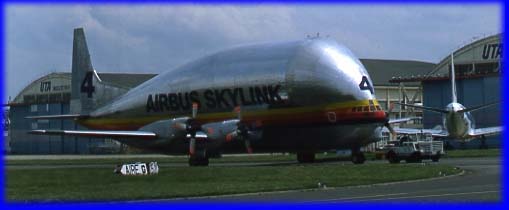 |
The Aero Spacelines Guppy was a conversion of
the early post war Boeing Stratocruiser. Its origin lay in the need
to transport enormous components of spacecraft for America's space
programme. The concept was for a gigantic bulge to be added to the
top of the fuselage, an enlarged tail for lateral stability, and
more powerful and reliable turboprop engines.
Four Guppies were acquired by Airbus to
transport major components, such as wings, between the different
factories of the consortium members. This one (F-WEAI) was seen at
Paris - Le Bourget in May 1983. They have now been superseded by an
in-house equivalent, the Airbus ST |
 |
The Boeing 247 was really the first of Bill
Boeing's classic airliners. In the same class as the Douglas DC3, it
was a low wing, twin engined design seating about 20 passengers.
These two airliners, together with the earlier Ford Trimotor,
ushered in the age of practical long-distance air travel. In the
second world war, many were taken over for military transport
service under the designation C-73.
Very few Boeing 247s remain today. This one, in
the process of restoration, was pictured at Paine in September 1981. |
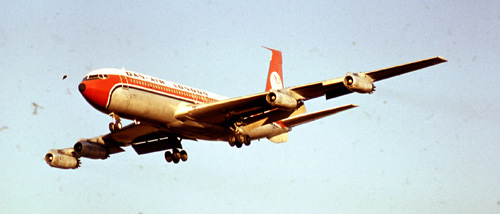
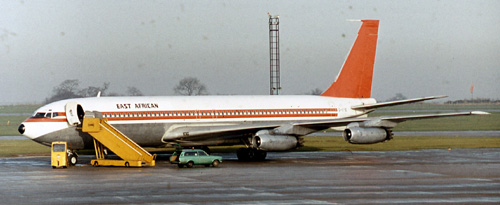 |
The Boeing 707 is one of the classic
airliners of all time. Launched against stiff competition from the
De Havilland Comet, Douglas DC8 and Convair Coronado, the 707
quickly proved the winner. It used structural components from the
B47 Stratojet bomber as the basis for the wing. 1,010 were built
between 1954 (it first flew in June of that year) and 1978. The 707
set the benchmark for long-range jet design over many years, only
being surpassed by the Boeing 747 in the 1970s.
Many variants have served with the US Air Force,
including the VC-137 executive transport (the original `air force
one'), and the E-3 AWACS, E-6 TACAMO, E-8 JSTARS, C-8 and C-18 special
mission aircraft.
Top picture: Dan-Air 707 (G-AYSL) landing at
Newcastle in the 1970s. Lower: 707 of East African Airways at East
Midlands, September 1976. |
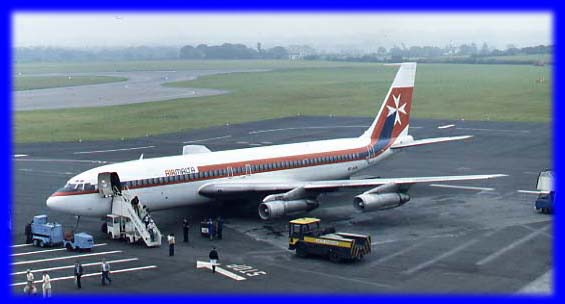 |
No, not another 707, but a Boeing 720. This
was structurally similar to the 707 but was shorter and very much
lighter, optimised for high-density shorter range operations. 154
were built. It first flew in November 1959.
This Boeing 720, operated by Air Malta, was seen
at Newcastle in the mid 1970s. |
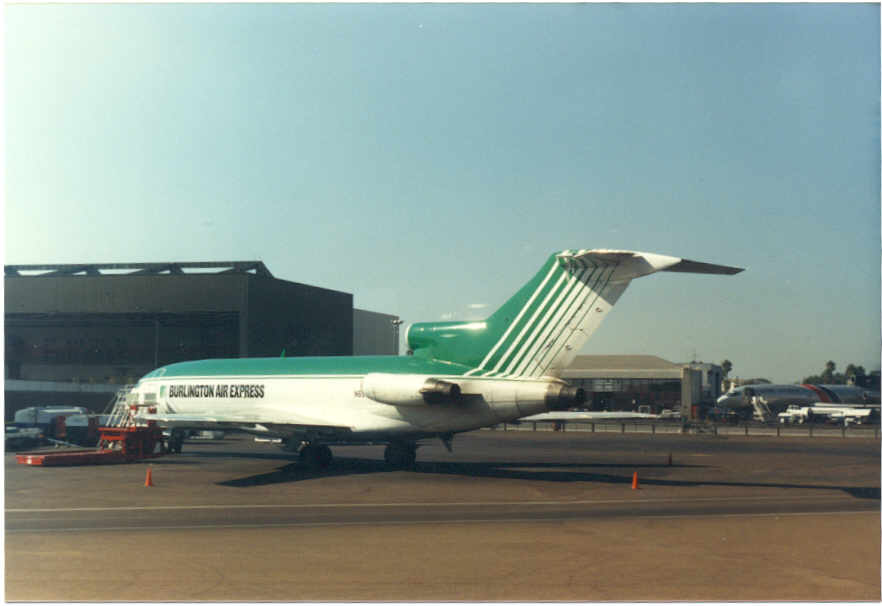 |
The Boeing 727 was designed as a medium-range
airliner for routes which did not justify the full intercontinental
range of the 707. It first flew in 1963 and was an immediate
success. Seating for up to 190 people (depending on exact variant
and layout) ensured it was profitable for the operators. 1,813
were built, making it the world's best selling airliner until
overtaken by the 737. They were exported throughout the world, though naturally most
were operated in the USA. A small number of 727s was operated
by the US Air Force as C-22s. With the introduction of the 757 in the 1980s,
many 727s found a new role as freighters. This example is operated
by Burlington Air Express and was photographed at San Diego in 1988. |
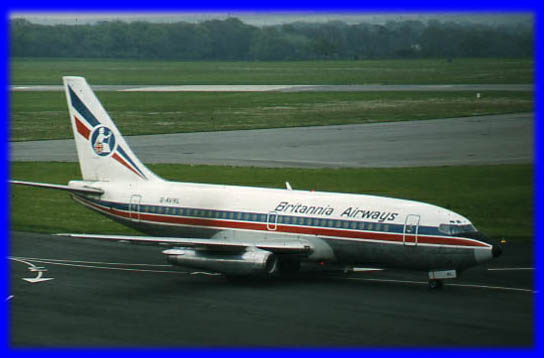
 |
The Boeing 737 first flew in April 1967 and,
in much updated form, is still in production at the time of writing
(January 2005). The fuselage cross-section and many other key
components are shared with the larger 727. Many versions have been
produced, ranging from 110 to 188 passengers. To date, over 4,250
737s of all types have been built. Major
variants are the original series 100/200 (illustrated here at
Newcastle in May 1976) with noisy Pratt & Whitney turbojet engines.
The series 300/400/500 with quieter, more efficient CFM56 turbofan
engines was launched in 1984. The series 600/700/800, with a new
wing, uprated engines and improved flight control systems was
introduced from 1993. an example being illustrated from Seoul in
2005. 737s have been operated by the US air force as
navigation trainers (T-43) and executive transports (C-40). |
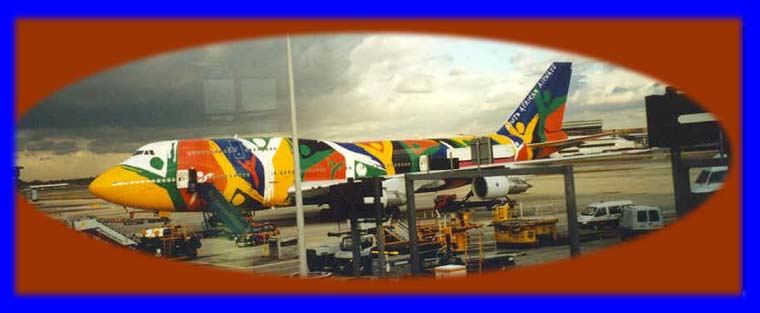
 |
The Boeing 747 is one of the most easily
recognised aircraft in the world. Originally conceived as a military
freighter, the `upper deck' was designed to give a clear fuselage
for big freight. When the freighter contract was awarded to Lockheed
(with the Galaxy - see under military freighters), Boeing bravely
developed the 747 as a private venture on the back of a single order
from the now-defunct Pan American airways. It first flew in 1969. It
introduced the concept of a wide-bodied, twin-aisle layout with up
to 10 seats across the cabin, and ushered in the age of mass
intercontinental travel. It is still in production (2004), with over
1,400 having been delivered to date. US military versions include
the C-19, VC-25 (the current `AirForceOne') and the special mission
E-4. The top
example (a series 300) is operated by South African Airways, painted in a special
celebratory colour-scheme, and was photographed at London's Heathrow
airport in 1998. The lower picture was taken at Seoul in July 2005. |
 |
The Boeing 757 was designed as a successor to
the 727. It first flew in February 1982. After a slow start, it has
become similarly successful; 1,050 had been built by the time
production ceased in November 2005. As with all recent Boeing
designs, it comes in a variety of options. Engines are either
Rolls-Royce RB211-535s or the Pratt & Whitney PW2037, -40 or -43,
ranging from 36,600 to 43,850 lb static thrust each. It can carry up
to 239 (in the normal version) or 289 (in the stretched series 300)
passengers for up to 4,300 miles in the longest range version, at
just over 500mph. The normal version is 155 feet 3 inches long; the
stretched series 300 extends that to 178 feet 7 inches. Wing span in
any case is 124 feet 10 inches. A small number serve as VIP
transports with the USAF, with the designation C-32. This one was
taking off from Cardiff, April 2006. |
 |
The Boeing 767 was developed concurrently
with the 757 and, at least in the earliest versions, shared a common
flight deck configuration and a common type rating for pilots. It is
however a widebody (twin aisle) aircraft, with seating for up to 290
(rising to 350 in the stretched version) in all-economy
configuration. The 767 preceded the 757 into the air, first flying
in September 1981. As is normal these days, it has a range of engine
options: Pratt & Whitney JT9D, P&W 405x or 4060, GE CF6, Rolls-Royce
RB211-524. Pretty well any high bypass turbofan with power rating
between 48,000 and 63,500 lb static thrust will do. Being wider it
is slightly slower (500mph typical cruise) but, with higher fuel
capacity, has longer range (up to 7,300 miles for the extended range
version). Maximum weight (for the stretched series 400) is
450,000lb. It has had two serious fuselage stretches: from 159 feet
2 inches (series 200) to 180 feet 3 inches (series 300) to 201 feet
4 inches (series 400). Wing span is the same 156 feet 1 inch for all
versions except the -400, which is wider at 170 feet 4 inches. So
far (and it is still in production at March 2006), 926 have been
delivered. It can be told from the similar Airbus A300 series by the
downward - curving rear fuselage under the tail, and from the more
recent A330 by the taller tail. This
one, operated by Air Canada, was at Heathrow, July 2005. |
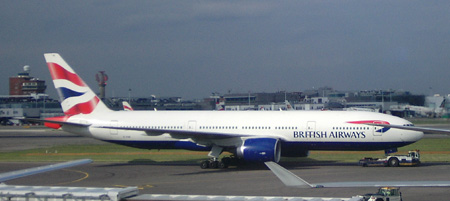 |
The Boeing 777, which first flew in June
1994, marked the first new Boeing design for well over ten years. It
is a colossal aircraft for a twin, with capacity for 550 people in
the stretched series 300, and weighing in at 750,000lb in its
heaviest variant. It is powered by the biggest turbofans in the
business, either the PW4074 / 84 or 90, Rolls-Royce Trent, or GE90,
with thrust ranging from 74,000 to a staggering 115,000lb each! For
its size, it is quick (maximum cruising speed is 540mph), and has
genuine intercontinental range (9,800 miles for the extended range
version). It started life being 209 feet 1 inch long, and the
stretched series 300 extends that to 242 feet 4 inches. Wing span is
just one inch short of 200 feet. Well over 500 have been delivered;
the type is still in production, and is very popular. From a
distance it could superficially be confused with the 767, but it has
a more pointy tail, and the rear fuselage ends in a vertical
straight line rather than a pointed cone. The relative size of the
engines and the cabin windows is a giveaway too.
(Heathrow, September 2005) |
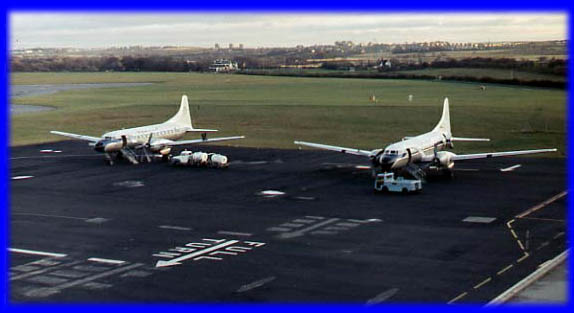 |
The Convair 440 was the final stretch of the
basic Convair 240 design, which first flew in March 1947. Powered by
two Pratt & Whitney radial engines and seating up to 52 people,
it was definitely one of the `old style' airliners. 571 were built
(of all variants), excluding military variants which are described
separately in the military transports
section.
These two CV440s, operated by Norwegian
charter company Nor-Fly, visited Newcastle in May 1976. |
|
|
The Convair 580 is basically a conversion of
the Convair 340 or 440 to take Allison turboprops instead of the
original piston engines. This increased the speed from 300 to 342
mph, and increased payload and range, but much more significantly
for operators, increased the time between overhauls for the engines
and thus substantially improved operating economics.
The top picture shows two CV580s operated by
Armstrong Cork visiting Newcastle in May 1976. It is interesting to
contrast them with the Dan-Air HS748 in the foreground, which has a
very similar capacity and range.
The lower picture shows a CV580 of Air Ontario
seen at Atlantic City in January 1988. |
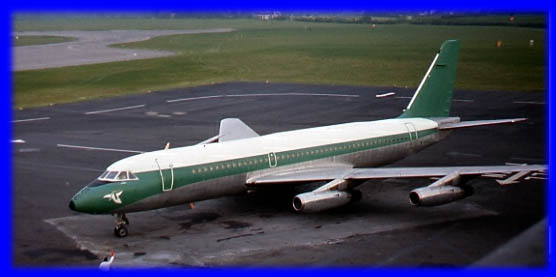 |
The Convair 880 was intended to compete with
the Boeing 720 and smaller DC8s over ranges up to 3,000 miles. Its
main selling point was speed, crising at 605mph to the Boeing 720's
587. But this marginal improvement was not sufficient to offset the
other disadvantages such as poor range and poor field performance.
Only 65 were built. The larger Convair
990 Coronado (not pictured) had the required range but had
significant stability problems, solving which held the performance
to below that of the competing Boeing and Douglas aircraft. Only 37
of those were built.
Pictured is a Convair 880 leased to Air Malta,
visiting Newcastle in 1978. |





|